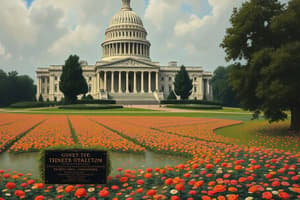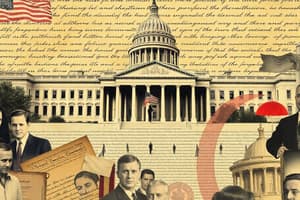Podcast
Questions and Answers
States had no government at all when America was born.
States had no government at all when America was born.
False (B)
America's central government is known as the federal government.
America's central government is known as the federal government.
True (A)
Federalism is the division of power between states.
Federalism is the division of power between states.
False (B)
The Constitution divides federal power among three branches of government.
The Constitution divides federal power among three branches of government.
Powers not given to the federal government are reserved for the states or the people.
Powers not given to the federal government are reserved for the states or the people.
Powers that states and the federal government share are called concurrent powers.
Powers that states and the federal government share are called concurrent powers.
The Supremacy Clause says state laws are superior to federal laws.
The Supremacy Clause says state laws are superior to federal laws.
Implied powers are stated in the Constitution and expressed powers are not.
Implied powers are stated in the Constitution and expressed powers are not.
The Constitution lets Congress do what is 'necessary and proper' for carrying out its powers.
The Constitution lets Congress do what is 'necessary and proper' for carrying out its powers.
Congress can't pass laws that have anything to do with powers it doesn't have, even if there is a link to a power it does have.
Congress can't pass laws that have anything to do with powers it doesn't have, even if there is a link to a power it does have.
People today still debate about how much power states and the federal government should have.
People today still debate about how much power states and the federal government should have.
The Founders had to create a federal government system because there weren't any other systems to choose from.
The Founders had to create a federal government system because there weren't any other systems to choose from.
An association of independent states is called a unitary form of government.
An association of independent states is called a unitary form of government.
A unitary form of government does not divide power between a central government and lower governments.
A unitary form of government does not divide power between a central government and lower governments.
What type of government allows the central government to have the most power?
What type of government allows the central government to have the most power?
What type of government ensures laws are the same throughout the country?
What type of government ensures laws are the same throughout the country?
What type of government allows the central government to have the least power?
What type of government allows the central government to have the least power?
What type of government allows individual states to maintain as much independence as possible?
What type of government allows individual states to maintain as much independence as possible?
What type of government includes both national laws and state laws?
What type of government includes both national laws and state laws?
What is the government type when you don't care whether individual states have any power?
What is the government type when you don't care whether individual states have any power?
What type of government seeks a balance between state power and central government power?
What type of government seeks a balance between state power and central government power?
What type of government maintains few, if any, national laws?
What type of government maintains few, if any, national laws?
Flashcards are hidden until you start studying
Study Notes
Federalism Basics
- States possessed their own governments when America was founded.
- The central government of America is referred to as the federal government.
Powers in Federalism
- Federalism involves the distribution of power between the central government and the states.
- The U.S. Constitution divides federal power into three branches: legislative, executive, and judicial.
- Powers not granted to the federal government are retained by the states or the people.
- Concurrent powers are those shared between the states and the federal government.
Superiority of Laws
- The Supremacy Clause establishes that federal laws take precedence over state laws.
Powers Defined
- Expressed powers are explicitly stated in the Constitution, while implied powers are not directly mentioned.
- Congress is authorized to enact laws deemed "necessary and proper" for executing its powers.
Legislative Authority
- Congress can connect new laws to the powers it holds, even if the laws pertain to areas not explicitly granted.
Ongoing Debates
- The balance of power between state and federal governments remains a topic of ongoing debate among citizens.
Government Systems
- Numerous government types exist beyond federalism, refuting the notion that a federal system was the only option.
- A confederal government represents an association of independent states.
- In a unitary government, no power division exists between a central authority and lower levels of government.
Types of Government and Power Distribution
- A unitary government centralizes power, ensuring uniform laws across a nation.
- A confederal system prioritizes state independence and minimizes the central government's power.
- A federal government accommodates both national and state laws, striking a balance in power distribution.
Studying That Suits You
Use AI to generate personalized quizzes and flashcards to suit your learning preferences.




